Overseas Chinese Mining and Spills
Air Date: Week of October 24, 2025
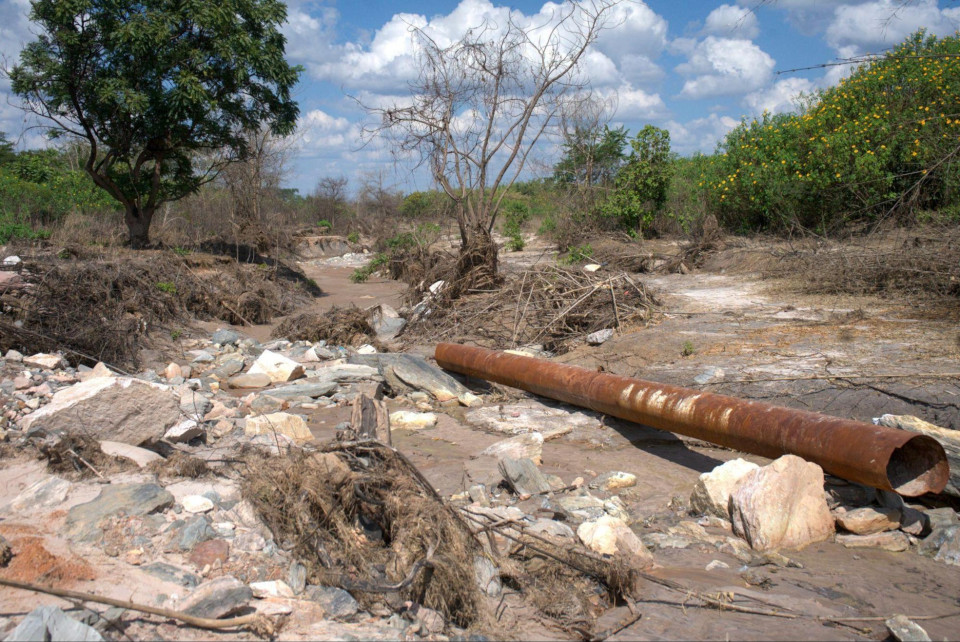
A landscape in Zambia 12 weeks after a Chinese copper mine spilled toxic waste laced with heavy metals, including lead, arsenic and uranium. (Photo Katie Surma, Inside Climate News)
As part of the Belt and Road Initiative, China has invested over $1 trillion in overseas infrastructure for projects that include mining in developing countries for minerals to fuel the clean energy transition. In the “copper belt” of Zambia, a Chinese-owned tailings dam collapsed, sending toxic sludge into homes and crops. Inside Climate News reporter Katie Surma speaks with Host Jenni Doering about the aftermath and “green colonialism” that appears to no longer be only at the hands of the Global North.
Transcript
DOERING: In 2013 China launched a global infrastructure and economic development project known as the Belt and Road Initiative. So far it has invested over $1 trillion in overseas infrastructure for projects like railways, dams and ports, as well as mining in developing countries around the world. Now, as China becomes a clean energy leader producing more solar and wind than the rest of the world combined, it needs more raw materials than ever. But extracting those materials needed for clean energy, especially metals, can come at a heavy environmental cost. Katie Surma is a reporter with our media partner Inside Climate News, and as part of their global series “Planet China,” she’s been looking at the impact of these projects in Africa. Katie, welcome back to Living on Earth!
SURMA: Thank you. Thanks for having me.
DOERING: So let's focus in on one particular part of the world where this is happening. You've been writing about environmental impacts from Belt and Road copper mining in the copper belt, this is a copper rich region across Zambia and the Democratic Republic of Congo. So what exactly is happening there in Zambia?
SURMA: Well, so we went up to look at a copper mine that's run by a state-owned Chinese company called Sino metals and in February, this company's, it's called a tailings dam, where it stores all of its mining waste, like huge sort of slag mountains with pools of millions of gallons of toxic waste, burst and flooded into local villages and riverways throughout the country. And so we went up to look at the impacts of that, but the region, more broadly, is just riddled with mining activity, both in Zambia and across the border in the DRC.
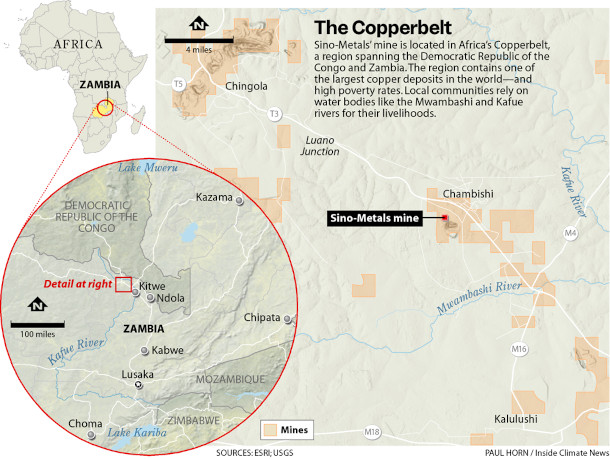
An infographic depicts Africa’s Copperbelt region. It shows the location of the Sino-Metals mine near to local waterways like the Mwambashi and Kafue rivers. (Photo: Paul Horn, Inside Climate News)
DOERING: So when this tailings dam burst, what happened with this like copper slurry going out into the surrounding area? And why was this dangerous for communities?
SURMA: Yeah, well, the villages that we talked to that were affected, the villagers, they said it sounded like a waterfall coming at them. You know, the tailings waste is acidic for one, so when the water was tested, you know, like river ways were tested after the spill, the pH in some areas was one, which is a level known to dissolve human bone, yeah.
DOERING: Wow. That's such a low pH, it's really acidic.
SURMA: Right? Yeah, exactly. And then, you know, it's also laced with heavy metals, arsenic, lead, uranium, so really dangerous stuff. You know, heavy metals don't dissolve in nature, they have to be physically removed. That's why tailings dams are supposed to be built to last 10,000 years. You know, mining sometimes gets a bit of a pass from environmentalists because it's mining green, so called green minerals for renewable energies in some cases, but the waste that comes out is really dangerous, and so the people living in the villages we went to, these are folks who rely on farming, both for their income and also it's what they eat. When they don't have money to buy other food, they survive on what they grow, and when the waste washed through, their livelihoods were done. I mean, they can't eat, they don't have any other way to make money, and their water sources are entirely contaminated. So what the company's been doing is bringing them like little packs, 300 milliliter packs of water to use and they're supposed to survive on that. But the spill has been absolutely devastating. And then, you know, that's just the immediate impact on the villages. I mean, this stuff has gotten into the waterways and washed far throughout the country.
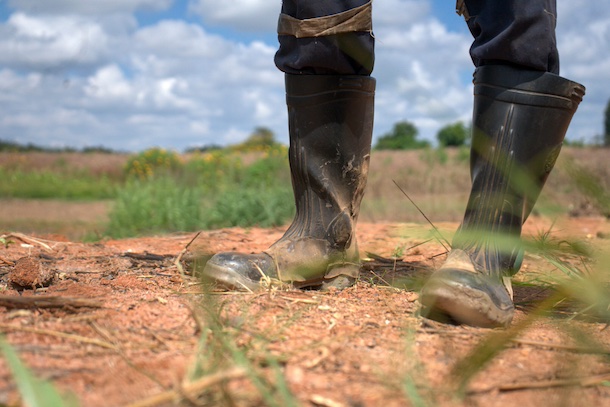
Boniface Sichalwe walks through an area where millions of liters of toxic mining waste spilled earlier. Sichalwe’s farm was completely decimated. (Photo: Katie Surma, Inside Climate News)
DOERING: Wow and yeah, I mean, it impacts this year's growing cycle, if they're making a livelihood from growing crops. But also, like, unless this stuff is cleaned up, years into the future, I can imagine.
SURMA: Yeah, that's right. And I asked people, do you know what's going to happen? People are fearful about the future, and they just don't know and there's a whole reason for why they don't know. Civil society workers and even these folks' lawyers have had trouble getting in to talk to them. The mine's position is that at least this one community is on the mine's land, and so they have restricted people from coming in. There's a lot of confusion, a lot of fear, like I said, about the future, not knowing what will happen, not knowing if they'll have new land or if they'll be able to farm their old land again.
DOERING: And I think you talk to a farmer who usually makes about $1,800 or so a year from what he's able to grow on his land, and he is seeing none of that this year, and the money from the company has not nearly been enough.
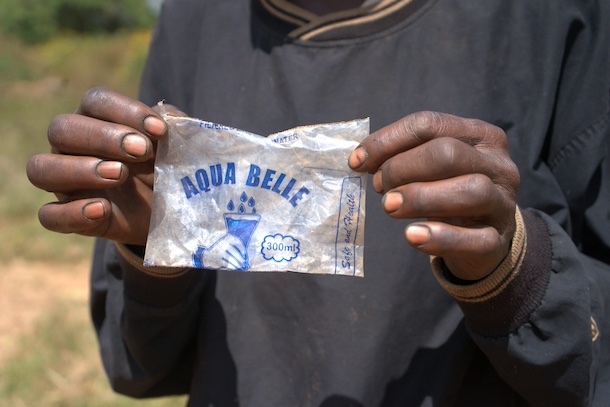
Boniface Sichalwe holds a used 300 milliliter water bag. The Chinese mining company Sino-Metals Leach Zambia has been distributing the water packets after the company’s toxic waste spill contaminated locals’ water supply. (Photo: Katie Surma, Inside Climate News)
SURMA: Yeah, that's exactly right, Bonifast. You know, in a typical yield of harvest, he said he'd make about 1,800 US dollars. And one of the things that was really heartbreaking about his story, and just all of this, is the year before, Zambia has had a horrible drought, a climate, you know, induced drought, people starved, and folks lost their yield that year. And so this year, they thought, we're having rain, things will be good. And then this tailing dam burst hit, and they lost everything again. And the compensation payments, what folks civil society people have told me, they range from 17 US dollars to 2,000, they're meant to be interim payments. But I mean, people were saying, like, "how are we supposed to survive?"
DOERING: And meanwhile, to receive those payments, you also just wrote about how people were asked to sign away their rights.
SURMA: Yes, so I received from a source, one of these settlement and release agreements that Sino metals, the company had locals sign before they got their compensation payments. These were compensation payments that the Zambian government ordered Sino Metals to make. And the government has not given me a response or a comment on this, but the text of these settlement and release agreements says that the payment recipient waives all their rights to sue Sino Medals, essentially. And there's two sort of burgeoning lawsuits on the horizon that would collectively demand, I think it's $420 million for emergency funds and $90 billion for a longer term cleanup fund. This is not unusual, right? With tailings dam spills, these are so pervasive that they are in the tens of billions of dollars on magnitude of cleanup. And so, I mean, the company will use these agreements it got to try to shield itself. And it's worth noting too that a lot of these villagers can't read, they also didn't have access to lawyers because they were restricted from talking to their lawyers by the company.
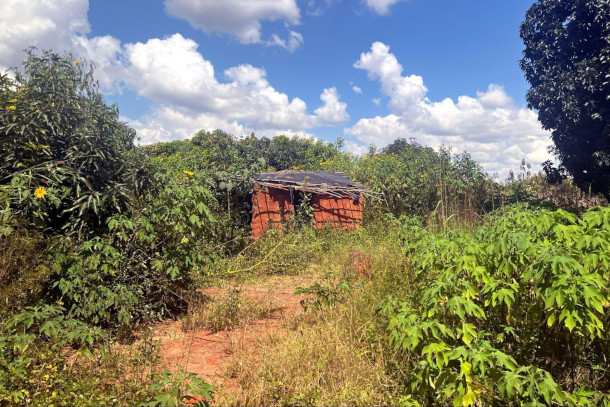
A home just outside of the Kalusale community in Zambia’s Copperbelt. (Photo Katie Surma, Inside Climate News)
DOERING: Yeah, you know, we're really facing an existential crisis when it comes to climate change, and the clean energy transition is vital to reducing emissions. But what does this transition really mean for local communities who are exposed to extractive mining industries?
SURMA: Yeah, I think that's a great question. I mean, I think the starting place is acknowledging that climate change has to be addressed. We're breaching limits that scientists have said keep us within a safe operating space for humans. That being said, you know, by just saying we need to deploy more renewable energy without addressing those deeper justice issues, that's, it's not a solution. When I talk to sources in South America or Africa, they see the global north's energy transition as green colonialism and beyond the pollution, mining also is dangerous in terms of environmental defenders, people who try to defend their territories to protect it from harm. And I think the latest numbers are something like 320 human rights defenders are killed every year, and most of them are environmental defenders. One source said, people here die so that people in your country can drive electric SUVs. Just think we have to grapple with these difficult issues. It's a really hard problem to solve, but I don't think you know it serves us to not recognize these justice issues.
DOERING: Katie Surma is a reporter at Inside Climate News, covering the rights of nature movement and international environmental justice. Thank you so much, Katie.
SURMA: Thank you for having me.
Links
Inside Climate | “Chinese Mining Firm Downplays Toxic Waste Spill as Residents Reel From Impacts”
Inside Climate News | “The Woman Holding Chinese Mining Giants Accountable”
Living on Earth wants to hear from you!
Living on Earth
62 Calef Highway, Suite 212
Lee, NH 03861
Telephone: 617-287-4121
E-mail: comments@loe.org
Newsletter [Click here]
Donate to Living on Earth!
Living on Earth is an independent media program and relies entirely on contributions from listeners and institutions supporting public service. Please donate now to preserve an independent environmental voice.
NewsletterLiving on Earth offers a weekly delivery of the show's rundown to your mailbox. Sign up for our newsletter today!
 Sailors For The Sea: Be the change you want to sea.
Sailors For The Sea: Be the change you want to sea.
 The Grantham Foundation for the Protection of the Environment: Committed to protecting and improving the health of the global environment.
The Grantham Foundation for the Protection of the Environment: Committed to protecting and improving the health of the global environment.
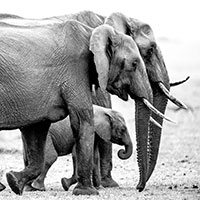 Contribute to Living on Earth and receive, as our gift to you, an archival print of one of Mark Seth Lender's extraordinary wildlife photographs. Follow the link to see Mark's current collection of photographs.
Contribute to Living on Earth and receive, as our gift to you, an archival print of one of Mark Seth Lender's extraordinary wildlife photographs. Follow the link to see Mark's current collection of photographs.
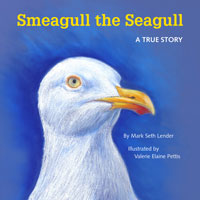 Buy a signed copy of Mark Seth Lender's book Smeagull the Seagull & support Living on Earth
Buy a signed copy of Mark Seth Lender's book Smeagull the Seagull & support Living on Earth

